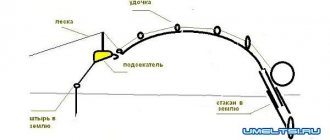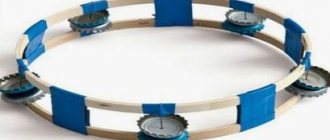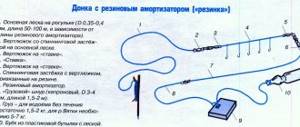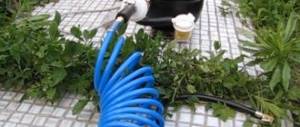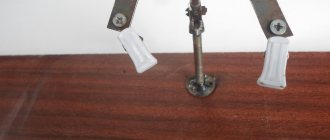Visual alarms
The basis of the work is monitoring the progress of the bite. This type of gear makes it more obvious, saves time and bait.
These include:
Nod
The nod is an inexpensive device, attached to the tip of the feeder, it happens:
- Lavsan , the same (polyethylene terephthalate) PET, the material of a plastic bottle. A lavsan nod is great for fishing with a jig, especially if with a bloodworm, in which case the jig plays better. The length of the nod should be 10-15 cm. Such a nod can be made at home by cutting it out from the same bottle and making a hole using a heated needle.
- A metal nod made of stainless steel is best suited at depths or currents, which makes it possible to perfectly distinguish between a fish bite and a current jerk, and it can be bent to improve the appearance of the bite. Its length is up to 18 cm. It consists of a metal plate 1.5-3 mm wide, the fastening should be a cone for free adjustment of the plate stroke, and at the end there is a plastic ring for the passage of fishing line. For the entire length of the nod, you need to install 1-2 cambrics to hold the fishing line. You can make it at home using a hard rubber band for a cone, plate, cambric, and ring.
- Spring nod , an excellent bite indicator in the case of heavy baits, especially for predatory fish. Used for fishing methods such as using a spinner or spinners. You can make it at home using a twisted spring 15-18 cm long, 2-3.5 mm in diameter, a rubber or plastic fastener and large beads with a hole for the fishing line to pass through.
- Balanced nod , works thanks to the principle of counterweight. A moving weight is attached to the end of the nod, which balances the mass of the tackle. Equipped with bearing. Perfect for winter fishing in a tent.
The upper nod - the bite alarm is made of dense foam. On the bottom - made of polyethylene foam
Manufacturing procedure:
- You will need a copper wire on which the sliding element will be located and rotate , and its upper part will prevent the nod from rotating around its axis.
- In order for the glide to be perfect and fit the size of the wire , you need to cut off a piece of the ear stick and secure it.
- The working part of the nod itself can be taken from old non-working metal nods.
- The balancing weight - lead or tin , moves along the nod, is fixed with cambrics and is selected according to the weight of the equipment.
Float
Fishing gear that does not require special financial costs. To make it, you need to take into account the depth of the reservoir, casting distance, and current speed. The choice of material and method of processing the float will depend on this.
Make it a rule, on every fishing trip, the first thing you do is start.
When purchasing or making a float, consider the following:
- A heavy float weighing 3-10 grams is designed for casting a fishing rod at least 50 m ; it is designed for larger fish: a nice catfish or carp.
- A medium-heavy float weighing 0.8-2.5 grams will be needed on bodies of water with a current. This tackle is perfect for large crucian carp or silver carp.
- A light float weighing up to 0.8 grams is used for catching fish near the shore. Very sensitive and responds even to a barely noticeable bite. Used for catching roach, rudd, sebel, crucian carp.
Let's consider options for making light floats at home; they will cost pennies, and they can be made in a matter of minutes.
To make it you will need:
- Styrofoam;
- wine stopper;
- goose or duck feather;
- cane.
Additional materials include: colored acrylic paints, waterproof glue, wire, toothpicks of different lengths.
Tools you will need: drill, sandpaper, sharp knife, drill (diameter 2 mm).
Varieties:
- Foam float. A cylindrical piece 5 cm long and 2 cm thick is cut out of dense foam plastic. Next, a long toothpick is inserted into this workpiece, and its other end is inserted into the drill chuck, which is tightly secured in a vice. While the drill rotates the workpiece, you need to sand it using sandpaper and give it the desired shape. Then the toothpick is removed and a new one is inserted, having previously been “planted” on the glue to a depth of 2/3 the size of the float. The polystyrene foam is painted with bright paint; you can use nail polish. To attach the float to the fishing line, a swivel carabiner is attached to its lower part. The process for making a float from a wine cork is identical; moreover, the cork does not need to be sanded, but simply covered with several layers of paint.
- Duck or goose feather float. The feather is first cleaned of fluff using a sharp knife and held over low heat to remove excess fluff. Since the length of the feather can be different, the float will need no more than 15 cm. We paint it in a bright “poisonous” color, attach two rubber rings in the middle and at the bottom of the float and attach it to the fishing line.
- A reed float is made in the same way as a feather float, and besides, you can make it right while fishing, just taking nail polish with you.
Foil tubes
Cheap and easy. It works by oscillating the line. Done in 5 minutes.
How to make at home:
The material used is aluminum foil and rolled into a tube. Slides onto the main line. It is important to thread the line between the first ring on the feeder and the reel to create slack in the line.
The first ring of the feeder should be thicker than the tube itself. When biting, the sag of the fishing line will decrease. Foil “plays” well in the sun and rustles, but due to its lightness it is useless in the wind.
fireflies
Excellent tackle for night fishing. Thanks to the fluorescent glow, it is clearly visible in the dark. Used with spinning rods, fishing rods, and other gear.
How to do it yourself? There are several options worth considering:
- Take white or yellow foil and cut it into strips about 5 mm wide. Apply the finished strips to the float antenna using waterproof glue. To check it in action, you should shine a little light, you can take a flashlight.
- Purchase specialized phosphorus-rich paint that can glow in the dark and apply it to the float.
- To make it you need to take: a stationery clip, a clothespin, a fishing firefly.
Types of existing alarms
The most famous and most used bite alarm is a regular float
, used in various equipment when fishing with a float rod. But in recent years, bite alarms for feeders have become very popular. This is not surprising, given how popular this method of catching bottom fish is becoming.
There are several types of devices that help the fisherman not to miss a bite. This:
- visual alarms;
- sound alarms;
- hybrid;
- various electronic devices that can be classified as both visual and audio.
Visual categories include: various nods
,
beacons
,
fireflies
,
pendulums
,
glowing tubes
, etc. These are simple devices, the main working parts of which are made as bright as possible to attract the attention of the fisherman.
Expert opinion
Knipovich Nikolai Mikhailovich
Interesting!
For greater safety of glowing tubes, some manufacturers recommend storing them in the refrigerator.
Sound signaling devices include bells
,
bells
,
metal tubes
, etc. Sound devices are advantageous in that the fisherman does not need to constantly monitor them. A sound will notify him of a bite.
Electronic devices mainly include industrial products.
, which can be purchased at retail outlets.
The main disadvantage of electronic assistants is their high price and insufficient protection
from external factors (water, sun, dust).
The feeder alarm can be attached to different parts of the equipment, for example:
- To the very tip of the feeder rod.
Despite the fact that the tips of such rods themselves are considered quite sensitive and informative, the alarms installed there are never superfluous; with their help, hook detection becomes much more timely. Their main drawback is that before hooking or immediately after hooking, when landing fish, this device must be removed from the tip of the form.
- Directly at the butt of the rod, usually between the first and second guide rings. Most often, this is how the side bite alarm
for the feeder is attached. The main element of such devices is various elastic plates or springs. - Another option is to attach the device to a rod rack. Most often, nods of various designs are attached in this way, which are complemented by bells or bells
.
Do-it-yourself bite alarms for feeders, as a rule, take into account all the features of the gear for which they are adapted; moreover, they are much simpler and more reliable, and therefore can be much more effective than industrial models.
Sound alarm
The simplest are a bell or a rattle. The bell is often used at long distances on a spinning fishing rod.
Principle of operation
A set of fasteners in which, for example, a bell is attached to the top of a feeder. If it starts to peck, the top of the feeder, on which the alarm is attached, begins to oscillate and our device produces a sound.
The advantages include low cost, sensitivity to the slightest bites, and the ability to use over long distances.
Step-by-step manufacturing instructions
Would need:
- A flat spring about 20 cm long , you can take it from an old alarm clock or watch. It should be smooth, without errors.
- Aluminum wire 20 cm long.
- Plastic strip 20 cm long.
- Dye.
We make holes with different diameters on the sides of our spring. We fasten the plastic strip on one side with wire so that it holds securely against the passage ring. On the other side we make a hook that holds the spring.
Sound bite alarm
Mechanical alarms
The design of such products does not include batteries or radio control. All work is based on physical laws.
Swinger
It looks like a bulky structure with a plastic flag equipped with a loop. A cord is threaded through this loop. Another component of the system is a long lever with a 100-gram weight, on which there is a bracket that is attached to a support under the feeder.
When the fish starts to bite, the cord is pulled tight and the weight moves along the lever towards the swinger. All the action happens before your eyes, and you can instantly react to the activity of the fish.
Hanger
Among mechanical bite detection devices, hangers are the most sensitive. Structurally, it is a plastic oval with a line clamp at the top. Weights are attached to the bottom to tighten the cord. The product is fixed to the front crossbar using a chain.
Hanger
At rapid speeds and long distances, the weight of the weights is not enough, so manufacturers make additional weights that can be purchased separately.
How to make your own mechanical alarm
A steel wire 25-30 cm long and several plastic plugs will make an excellent guard. Bend the wire in 3 places. The angle of one fold should be straight: this side will attach the device to the rod with electrical tape.
Heat one end of the wire on a fire, put on plastic plugs. Attach the straight part to the fishing rod, and place the other, curved part on the fishing line. As soon as the fish touches the hook, the curved section will jump off the line: a pendulum effect will be obtained. All you have to do is hook the fish.
Side warning light
Or, as experts say, lateral quivertype. The device is based on a fastening to the feeder form and a springy part made of plastic or metal. Placed between the coil and the first ring of the feeder.
How does it work
After casting, the line is threaded into the hook, which is located at the end opposite from the feeder. The length of the chassis is about 10-15 cm. We place the side quivertip to the feeder form at an angle of 90 degrees. When the bite starts, the device will become almost parallel to the feeder.
Important advantages are:
- works in any weather conditions;
- Suitable for use on the winding banks of reservoirs, where there are many cliffs and snags.
Since the bulk of quivertypes are made of fiberglass, the big disadvantage is its excessive softness, which means that in the case of a strong current its sensitivity is lost. Also, this material, even under light loads, can begin to delaminate.
How to make a quivertype
To make a quivertype at home you will need:
- 15-20 cm of metal spring wire;
- metal tube with a diameter of 2 mm and a length of 5 cm.
At a distance of 15 cm from the coil, we fix the tube on the feeder form. Next, we make a Z-shaped hook at one end of the wire, and bend the other at a right angle for fastening in the tube. We place the finished product on the feeder and throw it out. We insert the fishing line into the quiver tip hook. For better visibility, attach a bright colored ball to the end of the hook.
Side bite alarm for feeder
How to install a bite alarm on a feeder
For feeder hunting to be successful, you need to properly attach the bite controller.
Installation of an electronic alarm
It is convenient to use the rod-pod system to place gear. It is better to install bite indicators on a stand using a threaded connection. The working thread must be passed through the roller of the electronic device. If the reel is equipped with a baitrunner, then the clutch should be released.
The device is configured using specific buttons, adjusting the tone and volume of the alert, and the degree of sensitivity of the device to bites. The length of the brace will depend on gusts of wind, its direction, and hunting conditions.
Attaching the bell to the feeder
You can fix the bell on the rod using any household clamp. A more reliable option is to mount the device by combining a hook with wire/jute. The bite alarm should be installed 20 cm from the top of the fishing tool.
Using special devices to control the bait makes fishing more comfortable and productive. The trading network has different options for devices, including light, beepers, and electronic, which makes it easy to choose the best model for specific fishing conditions.
Electronic signaling devices
This modern miracle of technology is equipped with light or sound devices, with the help of which the bite can be seen instantly.
How does it work
- It is installed on the shore of a reservoir and attached to a fishing rod.
- The fishing line must be threaded through a special roller, a hole on the alarm, and connected to the slot of the reel.
- When the bite starts, the built-in gear on the roller will move and a signal will sound.
The advantages of electronic signaling devices include:
- Hypersensitivity. The time and intensity of the bite is clearly visible.
- Thanks to sound and light indicators, there is no need to be constantly near the fishing rod.
- Works in all weather conditions.
- Long distance is not a barrier.
Experienced fishermen say the only drawback of this device is the inconvenience when fishing in “still” water. If the fish does not go “to the shore” when biting, then you can simply not notice it.
Electronic bite alarm
How to do it yourself
To make it cheaper and more efficient, you need to use the most ordinary keychain with sound as a basis. The contacts of the key fob, preferably in the form of two plates, should be removed outside.
We close the key fob button and attach it to the fishing rod stand. We take a piece of plastic (strip) 2 mm thick and attach it to the fishing rod between the first ring and the reel and bring it out between the contacts. As soon as it starts to bite, the line will pull out the plastic, a short circuit will occur and the music will start playing.
The benefits of fishing with a signaling device
Regardless of the variety, all alarms have one task - to respond to fish touching the bait, to notify that a bite has occurred. Among the positive advantages it is worth noting:
- you don’t need to be constantly on guard when fishing on a feeder;
- increasing comfort while fishing;
- ensuring timely cutting;
- the ability to fish with several gears at the same time;
- a wide variety of devices in retail chains.
By using a bite alarm when fishing on a feeder, the angler has more free time. The process takes place in pleasure and regularity. This is an assistant for those who like to hunt trophy specimens such as catfish, bream, carp. If you don’t react in time and miss the moment, then such large individuals will instantly disappear into the thickets along with the hook and bait, damaging the tackle.
To prevent the loss of prey and preserve the equipment, it is worth using a device such as a bite alarm. It will be especially useful when fishing in the dark. As soon as the fish is hooked, he immediately notifies the fisherman sitting by the fire.
Step-by-step assembly of an electronic bite alarm with your own hands
First of all, select one tube and cut a piece approximately 3-4 cm long.
Next, take hot glue and fill the cut piece of tube with it.
We take the LED and insert it into the tube with glue so that the legs of the light bulb stick out about half a centimeter. Place it aside and wait for the glue to cool.
Next, take one battery and heat-shrink tube. Note that the handset must be selected according to the size of the battery. We insert the battery into the heat shrink and cut off approximately 2 cm.
We insert the battery deeper so that it is in the middle. Next, use a lighter to slightly heat the heat shrink so as to obtain a workpiece similar to the one shown in the figure below.
We insert the tube with the LED into the heat shrink so that the contacts are on the battery contacts.
Now warm up the heat shrink thoroughly so that it fits tightly to the tube with the LED. During heating, it is necessary to periodically shake the tube with the LED so that it does not stick.
- See also how to make a homemade underwater metal detector
If the heat shrink no longer narrows, you can go the opposite way and increase the diameter of the LED tube. This can be done using hot glue. It is important that all contacts remaining in the heat shrink are as tight as possible.
At the free end we simply glue a small piece of tube. The firefly can be adjusted if you use the corrugated part of the tube at this stage.
At the end we glue a hairpin on this piece of tube.
The electronic rod bite alarm is ready. To use it, you just need to insert the tube with the LED into the appropriate place and the light will light up. Next, using a crocodile hook, we attach the alarm to the tip of the fishing rod, fix it in any convenient position and wait for the signal.
Video instructions for creating an electronic bite alarm:
Kinder bite alarm
Before you start making our device, you need to prepare the following parts and tools:
- Wire (diameter up to 2 mm).
- Cambric (you will need to lay a wire folded in half in it).
- A large-diameter ball (an oval-shaped case from a Kinder Surprise for children is perfect).
- Large beads.
- Clothespins from old baguettes.
- Pliers, drill, wire cutters, drill bits.
At the very beginning of work, you need to drill a hole in the clothespin using a drill. The diameter of the hole must match the thickness of the wire. The wire should fit freely into the resulting hole, but the clothespin should not dangle from it.
You need to insert the wire into the resulting hole and bend it.
Steel wire must be tightly wound around the resulting structure. The approximate number of turns is 12. Having wound the wire, it must be removed, but carefully so that the turns are preserved.
- See the review of the Deeper wireless echo sounder for ice fishing
How does a bite alarm work?
The principle of operation of the donkey guard is based on the fact that at the moment of a bite, the fishing line transmits vibrations of the equipment, recorded by a signaling device. The fish, having grabbed the bait, moves in any direction. The donkey alarm responds to fishing line pulls, regardless of their strength.
A powerful jerk is much more noticeable - it can be recorded by both a factory and a homemade device. Large fish often bite cautiously, and it is important for the alarm to be sensitive in order to detect such a bite.
Requirements for signaling devices for donkey:
- high sensitivity;
- simplicity of design;
- protection from water;
- reasonable price.
Each angler chooses bite indicator devices depending on:
- fishing conditions;
- own needs;
- weather conditions;
- expected fish in the catch;
- time of day.
At night, visual indicators are ineffective, even with lighting. It is impossible to sit for several hours without taking your eyes off the rod, and if you are distracted, you will miss the bite. Therefore, at night, sound sensors are needed for donkeys. And if they also provide a visual effect, the return on such equipment increases significantly.
The weight of the transducer is important, and this concerns not only the convenience of the angler. In strong winds, a lightweight design will show false bites, and the meaning of the device itself is tripled.
Buying a signaling device is not difficult; stores sell models for both summer and winter fishing. But quality equipment doesn't come cheap. Therefore, many fishermen prefer to make sensors themselves from scrap materials; it is cheaper and takes a little time.
The simplest signaling device consists of three main elements:
- The axis is a wire up to one millimeter thick.
- The body is an old float, a Kinder Surprise capsule, a piece carved from hard foam plastic, a bottle cap.
- The pipe is for cocktails, juices, flags, pens, and the like.
Alarm materials
We select materials for the manufacture of our signaling device.
Selected materials
We drill a through hole in the body of the float to allow the wire axis to pass through. Cut a three-centimeter piece from a long tube.
We put a short tube, a signaling device body, and a long tube onto the axle in succession.
Signal elements on the axle
At the rear end of the wire we make a loop for attaching to the ring of the bottom rod. In the case of using rigid wire, for the convenience of making a signaling device, it should be annealed over a fire. For convenience, it is better to bend the wire on a mandrel made of a tube with a diameter of a centimeter or a little more.
Rear end bend
Having moved all the elements of the product to the rear end, we begin to bend the front end of the axle. This loop should be in a plane perpendicular to the plane of the back bend. The diameter of the front loop may be slightly larger than that of the back, and be approximately two centimeters.
The loop should fit into the front tube about one centimeter. A longer piece will be awkward to insert into the tube; a shorter piece will constantly fly out of it.
Front bend
On every fishing trip, it is important to always clearly determine the moment of the bite. Many experienced fishermen prefer to make a bite alarm with their own hands, although there are many industrial auxiliary devices for this.
Depending on the fishing method, equipment, as well as weather conditions, certain devices may be used.
DIY bite alarm
The most common homemade donkey gatehouses are:
- pendulum type;
- nod type.
A homemade universal signaling device for donkey is mounted on a fishing line and attached to the rod rings. When a fish bites, the tackle, which is in a tense state, changes its position in the water, and the fishing line moves, transmitting vibrations to the guard.
The advantage of such a signaling device is that it is attached to the rod and remains hanging on its ring when hooking. However, the fisherman needs to monitor the bottom tackle with a hand-made pendulum sensor for the bottom in order to make a hook in time.
The easiest way
To make the simplest pendulum tracking sensor for a donkey you will need:
- a piece of aluminum or copper wire 20−25 cm long;
- 2 cambrics with a diameter slightly larger than the diameter of the wire section;
- lead weight with a ring;
- pliers.
The procedure for making a homemade tracking sensor for a donkey:
- put the weight on the wire and fix it in the middle by twisting the wire into a ring;
- put cambrics on the wire;
- bend the ends of the wire into rings and secure them with cambrics.
Mounting on the bottom:
- move the cambric and hook the wire ring to the lower ring of the rod;
- secure the gatehouse with cambric;
- move the second cambric and put the ring on the fishing line;
- secure the ring with cambric.
Due to the weight, the homemade signaling device will tighten the fishing line, and when there is a bite, transmit a signal about this, moving in the vertical direction.
After fishing, the bite indicator is removed from the fishing line and stored in the tackle box. It will take 5-7 minutes to make such a device; it is easy to transport and use.
Pendulum signaling device
Homemade pendulum alarms are attached to the tensioned line of the fishing rod and, when biting, make movements similar to the movements of a pendulum.
The simplest pendulum guard consists of:
- bell;
- rubber stopper or rectangular piece of foam rubber.
To make such a device you need:
- cut a piece of rubber in the shape of a parallelepiped, measuring 5x2x1 cm;
- insert a bell ring from the end of the rubber and secure it with wire or thread;
- At the opposite end of the rubber, make a cut with a blade to fix the sensor on the fishing line of the fishing rod.
After casting the tackle, the rod is placed on a stand, and the guard is attached to the fishing line below the last ring of the rod. Due to the weight of the indicator, tension is created in the fishing line; when biting, it begins to move in a horizontal plane, warning the fisherman about the need to hook.
After hooking, the alarm flies off the line, without creating problems when landing the caught fish. In order not to look for a flying guard in the grass, a piece of thin rope or fishing line is attached to the elastic band, the other end of which clings to the rod stand.
Kinder bite alarm
The simplest wire donkey alarm can be improved with the help of a plastic case from a Kinder Surprise toy. It needs to be secured to a fishing line instead of a lead weight, which will make it possible to adjust the weight of the weighting agent.
In strong winds, pendulum alarms for donkeys turn out to be ineffective due to false alarms. It is necessary to make the load heavier, and to do this, additional lead weights are placed in the body of the Kinder Surprise.
A lightweight sensor is more sensitive, but if the weather demands it, it is better to make the structure heavier to provide the necessary comfort.
In order for the alarm for the Kinder Surprise donkey to be triggered when a fish bites towards the shore, you need to tighten the main line more strongly and put a load of at least 20 grams.
Electronic alarm
Electronic indicators for donkeys have serious advantages over other similar accessories:
- are highly sensitive;
- do not register false bites;
- fix bites towards the shore;
- allow the fisherman to take his mind off the gear;
- Easily mounted on stands or rod pods.
The high cost of electronic devices for donkeys quickly pays off with active use. Nowadays, Chinese-made electronic devices with attachment directly to the fishing rod have appeared in stores.
To install such a sensor on the tackle, you do not need a rod or stand; it is fixed on the form and does not require any additional devices. An electronic device can be made independently by those who know how to hold a soldering iron in their hands and are able to distinguish a resistor from a microcircuit.
For this you need:
- small plastic alarm clock;
- resistor;
- a piece of rigid steel wire 25-30 cm.
- the extreme contacts of the resistor are soldered together;
- the middle contact of the resistor is attached with a wire to the alarm clock board;
- the resistor is attached to the alarm clock body with glue;
- Using an awl, holes are made in the housing opposite the resistor hole;
- A nod with a curved tip is made from wire to attach the fishing line;
- a wire nod is rigidly attached to the hole in the housing (resistor).
Middle option
In the last decade, the use of electronic alarms in feeder fishing has been growing rapidly. Many well-known fishing brands have mastered the production of high-quality bite alarm kits that are resistant to wet conditions, shock loads and sudden temperature changes, and also consume small amounts of energy when activated.
The alarm is equipped with light and sound bite identification capabilities, which differ in the intensity and brightness of the transmission of sound and light waves. In addition, many kits are combined with transmitting devices or pagers for monitoring signals over long distances, as well as electronic swingers.
The principle of operation of electronic bite indicators is based on laying the cord of the tackle in the impeller of the device, which, spinning as a result of the tension of the cord, closes the contacts of the device. The process involves the conversion of mechanical energy into electrical energy, which is transmitted to the light diodes and sound buzzer of the device, thus producing a signal. The equipment runs on rechargeable batteries or disposable batteries.
The advantages of electronic indicators are obvious. After all, this is a complete automation of the biting process with the transmission of a distinct signal over a distance and traces of the remaining memory after the completion of the signals, which can be found out from the glow of the additional diode that remains for a couple of minutes. The fisherman does not need to constantly be at the gear, constantly monitoring its condition, but can calmly engage in any other activity, right up to sleep, and be sure that the electronic watchman will wake you up at the most crucial moment.
And even after waking you up, he will indicate, based on the tone of the sound and the color of the illumination, which tackle offers a chance of success. But the fisherman must understand that in addition to the comfort and benefits of fishing, electronic controllers will require additional costs for their maintenance, which consists of the constant availability of basic and reserve nutrients and their regular replacement.
All this entails additional spending of money. And the kits themselves are not cheap, they are dependent on moisture getting inside the case and cannot withstand serious deformations due to careless use. There are many fakes on the markets that imitate high-quality goods, not always significantly inferior to them in price. Therefore, when deciding to purchase, it is better to purchase an electronic set of indicators from well-known brands that provide a guarantee for their product.
The simplest bite indicators can be made independently, without any experience at all in working with electronics and electrical circuits. Some simple bite alarms do not even require the fisherman to have skills in working with a soldering iron.
Option #1
You will need:
- Light-emitting diode
- Small coin cell battery
- Heat shrink tube that holds the battery.
- Two silicone tubes, one of which must match the diameter of the LED.
First, you need to cut the heat-shrink tube so that when you place the battery in it, approximately 1-1.5 cm of tube remains on both sides. Insert a silicone tube inside, then use a lighter or other source of fire and burn until the tube is secured on both sides.
Important! From the side where the LED will be located, the tube should be removed.
Let us describe the manufacture of an intermediate version of the signaling device. it also uses an LED with batteries from a lighter, as well as a silicone tip from a pipette and metallized adhesive tape with electrical tape.
Photo 1. Take out the light block from the lighter.
Photo 2. We mount a piece of tube using metallized tape.
Photo 3. We place the structure in the silicone tip, sealing it with electrical tape.
The amount of adhesive tape must be selected in such a way that the stationary structure does not glow, and when biting, a glow appears, as in the next photo.
Photo 4. It glows, however!
There are also more advanced homemade products, the manufacture of which will require some experience and knowledge of electrical engineering and electronics (however, you can always try to find a radio amateur among your friends who will make a bite indicator for a nominal fee).
We invite you to familiarize yourself with: Do-it-yourself fish kukan: how to make it correctly
To make one of the relatively more complex bite indicators you will need:
- Cheap Chinese alarm clock (provides both a housing for the device and a speaker).
- A resistor from an ordinary computer mouse.
- A nod (a bicycle spoke will do, or just a metal wire of sufficient diameter).
The two extreme contacts of the resistor must be soldered together; later they will be connected to the battery. To the middle one you need to solder a wire that will be attached to the alarm clock board. Next you need to choose a place in the case for the resistor. After the location has been chosen, you need to use a heated awl or nail to make a hole in the body through which the nod will pass.
The resistor is fixed with glue. The nod is attached to the hole in the resistor. The finished product should be attached to the rod, the line should be wound by the nod so that it is taut. When the nod is deviated in any direction, this device emits a fairly loud sound signal, which notifies you of a bite towards the shore or away from the shore.
For the option with a reed switch you need:
- The body of the future device.
- Spring plate for reed switch, plate for attaching magnet.
- Sealed contact with magnet.
- Battery and indicator light.
The sealed contact is attached to a springy metal plate, at the end of which there should also be a ring for tying the fishing line. The plate with the reed switch is mounted inside the housing, and the optimal distance for attaching the magnet is selected experimentally. The case also contains a board with the radio components necessary for the bite indicator to operate, as well as a toggle switch and a battery of the required power.
Important! The toggle switch is necessary to ensure that the electronic alarm does not go off when transporting the device to a reservoir. This option is much more convenient than opening the case each time to remove the battery.
An electronic signaling device is a device that works by closing and opening an electrical circuit. Based on the type of signals supplied, indicators are divided into sound and light.
The easiest way to make an electronic bite alarm with your own hands is from a ready-made audio key fob. The key fob button must be closed. The contacts are brought out, and small metal plates are soldered to the ends. A piece of plastic no more than 1 mm thick is attached to the feeder line, which is inserted between the plates after casting the tackle. When biting, the line pulls out the plastic, the metal plates close and a signal sounds.
To create an electronic firefly you will need an aluminum tube and a regular medical syringe. Two AG3 batteries are inserted into one side of the cut syringe. The syringe is placed in an aluminum tube. An LED is placed in the opposite direction from the batteries, one end of which should be in contact with the body of the tube.
Creating a feeder bite alarm with your own hands has many advantages. Firstly, there is no need to spend a lot of money on buying expensive gear. Secondly, when creating your own bite indicator, you can be confident in its quality and reliability.
The easiest way to make a bite alarm with your own hands
All fishermen know how important it is to notice a bite in time and prepare for hooking. Today the market offers a very large selection of different alarms and floats. But, if you make a signaling device with your own hands, you can get a very high-quality product without spending a cent. The signaling device is quite simple to make and the work, moreover, does not take much time to make.
Bite alarm. Manufacturing.
In order to start making a bite alarm, you need to prepare the following materials:
- Wire. — Cambric (2 pcs). - Pliers. — Stationery knife or scissors.
It only takes 15 minutes to make a bite alarm.
Now you need to take the cambrics. This is necessary so that this design holds well and the fishing thread does not get stuck in the alarm. By the way, you don’t need to buy cambrics in a store, because this is exactly the thing that you always have quite a lot on hand.
For example, you can take any cable you have at home that will fit in diameter and remove part of its insulation. For this homemade product, it would be best to take a cable from a satellite or television antenna. Now you need to cut off part of the cable with scissors or cut the insulation with a stationery knife and remove it.
The positive thing about making a signaling device with your own hands is that no money is wasted in its manufacture. At the same time, you have a really high-quality alarm device of your own production, which is enough for many fishing trips. Due to the fact that this signaling device was made of aluminum, there will be no corrosion or breakage.
Perhaps many fishermen have encountered the fact that plastic analogues from stores cannot withstand a long period of use and quickly break. If you make a signaling device yourself, you don’t have to spend a lot of time and effort, and it turns out much better than a store-bought one. This kind of alarm works well when fishing with bottom rigs. Even the smallest bite will be noticed and you will be able to react in time.
When hooking and removing fish, the alarm will not interfere. The same will happen during long-distance casting of bait. In addition, there is no need to prepare the alarm for casting a fishing rod, because everything will always be ready for perfect operation. Source
Receive a selection of new homemade products by email. No spam, only useful ideas!
*By filling out the form you agree to the processing of personal data
Visual alarms
Such products are designed for visual control of bites. They are divided into several types:
- plastic thin upper tips for the rod;
- fireflies (glow at night);
- swingers;
- side nods.
Such alarms have the following advantages:
- suitable for use day and night;
- can be used in conjunction with almost any equipment;
- ease of manufacture
The price of bite alarms for feeders can vary significantly depending on the type of device. If you make it yourself, it can be completely free if you use available materials.
Fireflies
Firefly is an electronic feeder bite alarm designed for night fishing.
The design provides for a sealed capsule containing an LED and batteries. The alarm is attached to the fishing rod or bell.
There are also fireflies based on the use of special liquids. This is a small plastic capsule containing 2 liquids.
When a bite occurs, the liquids are mixed, as a result of which a chemical reaction begins, the device glows, indicating a bite.
Homemade firefly for feeder
You can make a homemade bite alarm for the feeder that will glow at night. To do this you need:
- A plastic tube 5-7 cm long (can be used for polyurethane foam).
- White LED. It needs to be inserted into the tube and secured with glue.
- 3V battery. Place it in the heat shrink tube to ensure a seal.
Connect the LED to the battery; you can use hot glue for insulation. You can attach the alarm to the tip of the rod using adhesive tape.
There are ready-made battery-powered fireflies on sale that begin to glow when the tension of the fishing line changes. They are more effective because they signal directly when a bite occurs.
Model options
Nod
Perhaps this do-it-yourself feeder bite alarm can be considered one of the simplest, but also one of the most sensitive
. To make it you will need:
- A 10-15 centimeter piece of any springy material with a small cross-section. It can be an elastic wire, a steel plate or a spring.
- A polymer or durable rubber tube 3 to 5 cm long. It is useful for attaching the nod to the tip of the form.
- Colored varnish.
At one end of the elastic element (nod body), using pliers, you need to make a small loop (ring) for threading the main fishing line into it. After this, using a polymer or rubber tube, the nod is attached to the tip of the fishing rod. This fastening should be tight, but at the same time it should not interfere with changing the length of the working part of the nod. This allows you to adjust its sensitivity. To make the nod more visible, you need to cover its body with a bright, waterproof varnish.
After securing the nod, we thread the fishing line through its ring, equip it and start fishing. Since the material from which it is made is quite elastic, there is no need to disconnect it from the form when hooking and subsequent fishing.
Such a homemade bite alarm, after equipping a fishing rod with it, can serve for quite a long time without repairs or additional adjustments.
.
Firefly
Firefly is a feeder alarm designed to detect bites at night
. As a rule, this is the name given to polymer tubes, which, after breaking them, preferably in several places, due to a chemical reaction, begin to glow in the dark. They usually complement visual homemade bite alarms for the feeder. It is also possible to attach such a tube, 3 to 6 centimeters long, to the flexible tip of a feeder rod. This is done using colorless tape or a polyethylene tube of suitable diameter.
In addition to such luminous tubes, you can use various phosphorescent (glow in the dark) materials and paints, as well as miniature LEDs
.
The principle of their operation is the same - fastening to the working elements of mechanical signaling devices (nods, pendulums, etc.).
In this simple way you can make a warning light
bites on the feeder, which will be noticeable at any time of the night at a distance of
up to 10 - 15 meters
.
Side warning light
Let's look at how you can make a side bite alarm for the feeder. Its principle of operation is the same as that of the nod, but the difference is that it is fixed slightly above the butt of the stick, in front of the first wire ring. To make such a bite alarm for the feeder, you will need the following:
- Elastic wire or thin metal plate about 200 mm long.
- A thick rubber ring 30 - 50 mm wide, with an internal diameter identical to the diameter of the fishing rod at the place where the alarm is mounted. To do this, for example, you can look for a silent block from a passenger car in a car store of suitable sizes.
- Colored cambrics according to wire diameter.
Manufacturing process:
- First, we prepare fasteners from a rubber ring. To do this, you first need to cut it on one side so that you can put it on the form from the side.
- After this, in the rubber fastener, in order to be able to fasten the elastic wire perpendicular to the form, it is necessary to make a hole. The hole can be made with a nail of suitable diameter heated over a fire.
Expert opinion
Knipovich Nikolai Mikhailovich
Zoologist, hydrobiologist. I am interested in fishing at a professional level.
Attention!
The hole can be made to run either along the whip or perpendicularly, depending on the size of the rubber ring. If the hole is made along the body of the rod, the end of the wire that will be inserted into it must be bent at an angle of 90 degrees.
- At one end of the wire (metal plate) we make a hook using pliers. The fishing line will be inserted into it.
- We fix the colored cambric near the hook. This will make the alarm more visible.
- We insert the elastic element into the rubber body of the fastener perpendicular to the fishing rod. The alarm is ready for operation.
After casting the tackle, insert the line into the ring and wait for the bite. When biting, when the fishing line is tensioned, the elastic element of the device will bend to the body of the rod. When hooking and retrieving, such feeder bite alarms do not need to be removed
, they do not interfere with the actions of the fisherman at all.
It is quite possible to supplement such a do-it-yourself feeder alarm with a small firefly, this will allow it to be used effectively for fishing at night.
Feeder float
The float alarm is not attached to the rod, but to the equipment. The float is thrown into the water along with the equipment. The disadvantage of such alarms is insufficient visibility, which is especially important when casting long distances.
The float is mounted on a fishing line between two locking rings made of silicone. First you need to measure the depth and then set the correct position of the float. The feeder should completely go to the bottom. In this case, the float must remain on the surface.
If fishing is carried out on a river with a strong current, such alarms are not recommended. Due to the current, the effectiveness of the alarm will be low.
Side warning light
Such a signaling device is attached to the fishing rod. There is a simple way to make a bite alarm for a side-mounted feeder:
- As a base, use a rubber “cushion” for the stabilizer or spring. Such products are presented in a wide range in auto parts stores. The inner diameter of the hole should be slightly less than the thickness of the feeder form at the attachment point.
- Cut the pillow into 2 parts.
- Cut the resulting sleeve lengthwise.
- Make a hole at the tip of the nod.
- Make a hole in the rim of the rubber bushing. To do this, it is best to use a hot nail or similar object.
- Install the nod into the hole and secure with glue.
To attach the nod to the rod, simply move the sleeve slightly apart. Insert a fishing line into the hole made in the nod itself. When the line tension changes, the nod will begin to move, indicating the activity of the fish.
Sources:
https://lakeking.ru/snasti/gadjet/signalizator/svoimi-rukami.html https://tehnoobzor.com/schemes/next-sh/2806-signalizatory-poklevki-svoimi-rukami-elektronnye-i-iz-kindera .html https://ribaku.info/snasti/donka/signalizator-poklevki-2 https://usamodelkina.ru/5594-samyy-prostoy-sposob-sdelat-signalizator-poklevki-svoimi-rukami.html https:// fishingadvice.ru/signalizator-poklevki-dlya-fidera/
